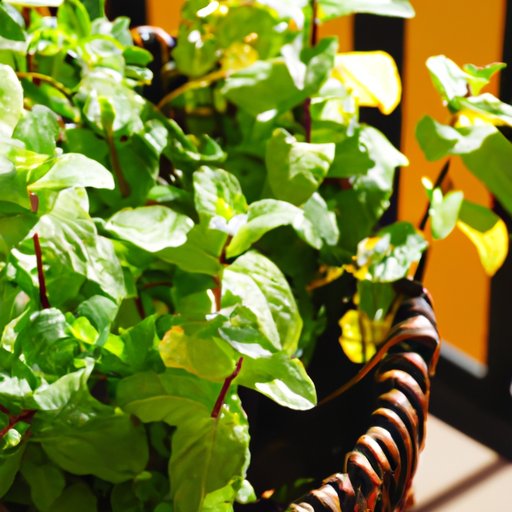
7 Tips for Growing Mint: A Beginner’s Guide
Mint is a fragrant and versatile herb that can be used in cooking, drinks, and home remedies. Growing mint at home is not only easy but also a great way to have a fresh supply of this herb at hand. Whether you have a large garden or a small balcony, you can grow mint almost anywhere. In this article, we’ll guide you through the process of growing mint from start to finish, including tips on how to care for your mint plants and overcome any issues that may arise.
Getting started with growing mint
Before planting mint, it’s essential to know the best conditions that will help it thrive. Mint prefers partial shade and moist soil that drains well. It’s recommended to plant mint in an area that receives four to six hours of sunlight every day. When choosing soil for mint, make sure it’s loose, well-draining, and slightly acidic, with a pH value between 6.0 to 7.0.
When planting mint, space them about 18 inches apart, as they can grow up to 2 feet high and also spread through underground stems called rhizomes. Water your mint plants regularly, especially during hot and dry weather, making sure not to let the soil dry out completely. Mint needs a lot of water to grow well.
Growing mint in containers
If you don’t have a garden or prefer to grow mint in a more controlled environment, you can plant it in containers. Choose a pot that’s at least 12 inches deep and wide, with adequate drainage holes. Fill the pot with good quality potting soil mixed with compost or manure to ensure proper drainage and nutrition for your mint plant.
Place your mint container in an area that receives partial shade and water it well, making sure not to overwater it. Container-grown mint needs more frequent watering than garden plants, especially during hot weather.
Growing mint indoors
Mint can also be grown indoors, provided that it receives enough light and humidity. It’s recommended to grow mint near a window that receives at least 4-6 hours of direct sunlight a day or use grow lights.
Mint also needs a humid environment. You can increase humidity by placing a tray of water near your plants or by using a humidifier. Ensure your plants are not exposed to cold drafts or direct heat sources.
When growing mint indoors, ensure to use a container that’s at least 8 inches deep and wide, with adequate drainage holes. Use well-draining potting soil, and water your plants regularly.
Top 5 mint varieties to grow
There are many varieties of mint, each with its unique flavor and aroma profile. Here are five popular and easy-to-grow mint varieties:
1. Peppermint: With its potent menthol flavor, peppermint is great for making tea and enhancing the taste of dishes like lamb and chocolate.
2. Spearmint: Spearmint has a refreshing, sweet flavor that’s perfect for adding to fruit salads, water, or iced tea.
3. Chocolate mint: This variety has a subtle chocolate flavor that works well in desserts like mint chocolate chip ice cream.
4. Pineapple mint: Pineapple mint has an exotic, fruity flavor that’s perfect for adding to drinks or fruit salads.
5. Apple mint: This variety has a light, fruity flavor that’s great for making tea or infusing water.
Propagating mint
Mint is easy to propagate from cuttings, seeds, or division. To propagate from stem cuttings, take a 3-4 inch stem from a healthy mint plant, remove the lower leaves, and plant it in moist soil. Keep the soil moist and place the pot in a warm, shady spot. In a few weeks, you should see roots developing.
To propagate mint from division, carefully uproot the plant and separate the roots and stems. Choose the healthiest stems and replant them in new soil. New growth should appear within a few weeks.
To grow mint from seeds, sow them in pots or directly in the ground in moist soil, covering them with a thin layer of soil. Keep the soil moist and in a warm, shady spot until the seeds germinate, which may take up to two weeks.
Harvesting and preserving mint
You can harvest mint leaves when they’re young and tender, usually in the morning when the flavor is at its peak. To harvest, gently pinch the leaves off the stem, leaving some growth behind. Avoid tearing the leaves as it may damage the plant.
You can use fresh mint leaves right away in cooking or drinks or store them for later use. To store fresh mint, place it in a jar of water, cover it with a plastic bag, and keep it in the refrigerator for up to 1 week.
To freeze mint, place the clean, dry leaves in a freezer-safe bag or container and freeze them for up to 6 months. To dry mint, hang the leaves in a cool, dry area for a few days, or use a food dehydrator at low heat.
Troubleshooting common problems when growing mint
Mint is a hardy plant with few problems, but some pests like spider mites and whiteflies may attack it. One way to prevent pest infestation is to keep the environment around your mint plants clean and healthy. Avoid overwatering, as it may lead to root rot or mold growth.
Mint can also be invasive and spread quickly, even into neighboring areas. You can prevent this by planting mint in containers or installing root barriers around the plant.
Conclusion
Growing mint at home is easy and rewarding, and with these tips, you can grow your own mint plants almost anywhere. Remember to choose a suitable location, soil, and watering regime that will help your plants thrive. Experiment with different varieties of mint and use them in cooking or drinks for a refreshing taste.




